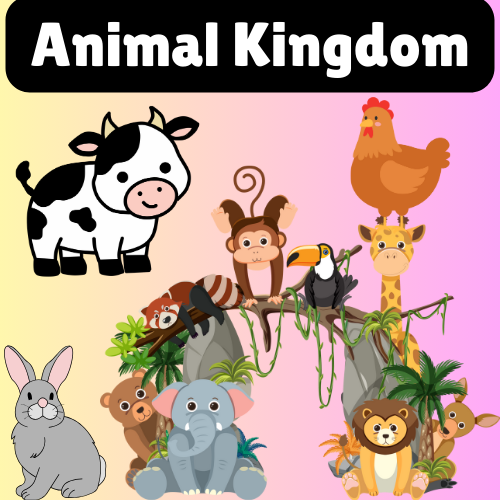

Welcome to our intermediate English lesson on discovering various animals! This lesson will expand your vocabulary by introducing you to a diverse array of animals found in the animal kingdom. You'll learn about common household pets and fascinating wild creatures, along with their unique characteristics. This is an essential part of your English learning journey!
Lesson Content:
Introduction to Various Animals:
In this lesson, you will discover various animals found in the animal kingdom. From common household pets to fascinating creatures of the wild, you'll learn about a diverse array of animals and their characteristics. This will enrich your English vocabulary and enhance your ability to describe different animals in English.
Common Household Pets:
Cat: A domesticated carnivorous mammal with soft fur. Example: The cat enjoys lounging in the sun.
Dog: A loyal and domesticated mammal often kept as a pet. Example: The dog wags its tail when happy.
Rabbit: A small herbivorous mammal with long ears. Example: The rabbit nibbles on carrots.
Hamster: A small rodent commonly kept as a pet. Example: The hamster runs on its wheel.
Wild Animals:
Elephant: A large herbivorous mammal with a trunk and tusks. Example: Elephants are known for their intelligence.
Lion: A large carnivorous feline known as the king of the jungle. Example: The lion roars to communicate.
Giraffe: The tallest land animal with a long neck. Example: Giraffes eat leaves from tall trees.
Zebra: An herbivorous mammal with distinctive black-and-white stripes. Example: Zebras often travel in herds.
Kangaroo: A marsupial from Australia with powerful hind legs. Example: Kangaroos hop to move quickly.
Marine Animals:
Dolphin: An intelligent marine mammal known for its playful behavior. Example: Dolphins communicate using clicks and whistles.
Shark: A carnivorous fish known for its sharp teeth. Example: Sharks are powerful swimmers.
Octopus: A cephalopod with eight tentacles. Example: Octopuses can change color to blend in.
Whale: The largest mammal, living in the ocean. Example: Whales migrate long distances each year.
Birds:
Eagle: A bird of prey with excellent vision. Example: Eagles soar high in the sky.
Parrot: A colorful bird known for its ability to mimic sounds. Example: Parrots are often kept as pets.
Penguin: A flightless bird adapted to life in the water. Example: Penguins are excellent swimmers.
Owl: A nocturnal bird known for its wisdom. Example: Owls have excellent night vision.
Reptiles and Amphibians:
Snake: A legless reptile that slithers. Example: Some snakes are venomous.
Frog: An amphibian known for its jumping ability. Example: Frogs live both on land and in water.
Turtle: A reptile with a hard shell. Example: Turtles can live in water or on land.
Lizard: A reptile with scaly skin. Example: Lizards can regenerate their tails.
Insects:
Butterfly: An insect with colorful wings. Example: Butterflies undergo metamorphosis.
Bee: An insect known for producing honey. Example: Bees play a crucial role in pollination.
Ant: A small insect that lives in colonies. Example: Ants are very organized and hardworking.
Ladybug: A small beetle with a red, spotted shell. Example: Ladybugs are often considered lucky.
Exercises and Activities:
Identify and Describe: Choose an animal and describe its characteristics and habitat in English.
Animal Habitats: Match animals to their natural habitats (e.g., forest, ocean, desert).
Welcome to our intermediate English lesson on discovering various animals! This lesson will expand your vocabulary by introducing you to a diverse array of animals found in the animal kingdom.
You'll learn about common household pets and fascinating wild creatures, along with their unique characteristics.
This is an essential part of your English learning journey! Lesson Content: Introduction to Various Animals: In this lesson, you will discover various animals found in the animal kingdom.
From common household pets to fascinating creatures of the wild, you'll learn about a diverse array of animals and their characteristics.
This will enrich your English vocabulary and enhance your ability to describe different animals in English.
Common Household Pets: Cat: A domesticated carnivorous mammal with soft fur.
Example: The cat enjoys lounging in the sun.
Dog: A loyal and domesticated mammal often kept as a pet.
Example: The dog wags its tail when happy.
Rabbit: A small herbivorous mammal with long ears.
Example: The rabbit nibbles on carrots.
Hamster: A small rodent commonly kept as a pet.
Example: The hamster runs on its wheel.
Wild Animals: Elephant: A large herbivorous mammal with a trunk and tusks.
Example: Elephants are known for their intelligence.
Lion: A large carnivorous feline known as the king of the jungle.
Example: The lion roars to communicate.
Giraffe: The tallest land animal with a long neck.
Example: Giraffes eat leaves from tall trees.
Zebra: An herbivorous mammal with distinctive black-and-white stripes.
Example: Zebras often travel in herds.
Kangaroo: A marsupial from Australia with powerful hind legs.
Example: Kangaroos hop to move quickly.
Marine Animals: Dolphin: An intelligent marine mammal known for its playful behavior.
Example: Dolphins communicate using clicks and whistles.
Shark: A carnivorous fish known for its sharp teeth.
Example: Sharks are powerful swimmers.
Octopus: A cephalopod with eight tentacles.
Example: Octopuses can change color to blend in.
Whale: The largest mammal, living in the ocean.
Example: Whales migrate long distances each year.
Birds: Eagle: A bird of prey with excellent vision.
Example: Eagles soar high in the sky.
Parrot: A colorful bird known for its ability to mimic sounds.
Example: Parrots are often kept as pets.
Penguin: A flightless bird adapted to life in the water.
Example: Penguins are excellent swimmers.
Owl: A nocturnal bird known for its wisdom.
Example: Owls have excellent night vision.
Reptiles and Amphibians: Snake: A legless reptile that slithers.
Example: Some snakes are venomous.
Frog: An amphibian known for its jumping ability.
Example: Frogs live both on land and in water.
Turtle: A reptile with a hard shell.
Example: Turtles can live in water or on land.
Lizard: A reptile with scaly skin.
Example: Lizards can regenerate their tails.
Insects: Butterfly: An insect with colorful wings.
Example: Butterflies undergo metamorphosis.
Bee: An insect known for producing honey.
Example: Bees play a crucial role in pollination.
Ant: A small insect that lives in colonies.
Example: Ants are very organized and hardworking.
Ladybug: A small beetle with a red, spotted shell.
Example: Ladybugs are often considered lucky.
Exercises and Activities: Identify and Describe: Choose an animal and describe its characteristics and habitat in English.
Animal Habitats: Match animals to their natural habitats (e.g., forest, ocean, desert).
|
|

FishFish |

A colorful fish swims gracefully in the aquariumA colorful fish swims gracefully in the aquarium |

ElephantElephant |

The elephant trumpets loudly in the jungleThe elephant trumpets loudly in the jungle |

LionLion |

The lion roars majestically on the savannahThe lion roars majestically on the savannah |

GiraffeGiraffe |

The giraffe stretches its long neck to reach the leavesThe giraffe stretches its long neck to reach the leaves |

MonkeyMonkey |

The monkey swings from branch to branch in the forestThe monkey swings from branch to branch in the forest |

TigerTiger |

The tiger prowls stealthily through the tall grassThe tiger prowls stealthily through the tall grass |

PandaPanda |

The panda munches on bamboo shoots in its enclosureThe panda munches on bamboo shoots in its enclosure |

DolphinDolphin |

A playful dolphin leaps out of the waterA playful dolphin leaps out of the water |

PenguinPenguin |

The penguin waddles clumsily on the iceThe penguin waddles clumsily on the ice |

KangarooKangaroo |

The kangaroo hops effortlessly across the outbackThe kangaroo hops effortlessly across the outback |

Polar BearPolar Bear |

The polar bear hunts seals on the frozen tundraThe polar bear hunts seals on the frozen tundra |

ZebraZebra |

The zebra's stripes blend into the grasslands.The zebra's stripes blend into the grasslands. |

RabbitRabbit |

The rabbit nibbles on a carrot in the gardenThe rabbit nibbles on a carrot in the garden |

HorseHorse |

The horse gallops across the fieldThe horse gallops across the field |

CowCow |

The cow grazes peacefully in the pastureThe cow grazes peacefully in the pasture |

SheepSheep |

The sheep bleats softly in the meadowThe sheep bleats softly in the meadow |

GoatGoat |

The goat climbs skillfully up the rocky hillside.The goat climbs skillfully up the rocky hillside. |
Q&A Section: Question: What is the tallest land animal?
Answer: Giraffe.
Question: Which marine mammal is known for its intelligence and playful behavior?
Answer: Dolphin.
Question: Name an insect that plays a crucial role in pollination.
Answer: Bee.
Question: What is the largest mammal living in the ocean?
Answer: Whale.
Question: Which bird is known for its ability to mimic sounds?
Answer: Parrot.
Fantastic! You have now expanded your English vocabulary by learning about various animals and their characteristics.
Practice using these words to enhance your communication skills and continue your English learning journey.
Keywords Section: Keywords: learn English, English learning, common animals, intermediate English lesson, English vocabulary, animal kingdom, household pets, wild animals, marine animals, birds, reptiles, amphibians, insects, describe animals in English